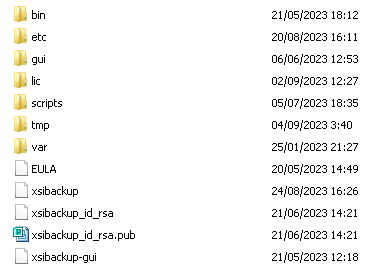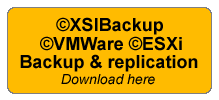|
Last updated on Wednesday 22nd of November 2023 10:19:34 AM ©XSIBackup-App: how it works and file layoutDetails on how backups work on ©XSIBackup-App applianceDirectory structure©XSIBackup-App follows the same file structure as the latest versions of ©XSIBackup-DC. ©ESXi files are stored in the /scratch/XSI/XSIBackup-DC folder while Linux files are stored in the /home/[user]/.xsi folder. You should respect the default locations, unless you know very well what you are doing, as ©XSIBackup will look for files in those folders by default. All files required to operate the ©XSIBackup server component are synced to the /home/[user]/.xsi directory automatically when you run some backup job against some Linux backend.  ©XSIBackup File Structure
©XSIBackup File Structure
You may be wondering why we haven't respected the Linux FHS convention. There are very good reasons for that since ©XSIBackup allows to use different users than root, some of them with limited sets of privileges. When you store a binary file to the /usr/bin folder you need to be root to set its permissions. If you aren't root you won't even be able to copy it there. When you are a non privileged user in a Linux server keeping binaries under the /home/[user] folder allows the [user] to use ©XSIBackup directly without requiring the root user intervention to set permissions or install software. The same principle is applied to storing the .ssh profile. As said the required ©XSIBackup binaries are installed to /home/[user]/.xsi/bin when the installation is performed automatically by the client. The binary has execute permissions on those binaries and also write permissions on the whole /home/[user] folder, thus you can use any Linux server where you have a non privileged user and some storage in the /home/[user] folder. SSL KeysAs you should know ©XSIBackup generates an RSA key pair to authenticate to backup hosts and storage back ends. The key pair is stored at the root of the installation directory for a given user. Thus the folders /home/root/.xsi, /home/alice/.xsi and /home/bob/.xsi would contain a key pair each. The arguments --add-host and --add-key allow to put your .pub key to the remote server's authorized_keys file. Then you can use your private key to authenticate via SSH. Everything is automatic, the principles in regards to the file exchange are simple to understand though. You can delve into how keys work here at SSH.com. The OpenSSH related files are stored at /root/.ssh for the root user and /home/[user]/.ssh for the rest of non privileged users when ©XSIBackup acts as a server. ©XSIBackup takes care to find the default location for every backup user and put the xsibackup_id_rsa.pub key to the corresponding authorized_keys file, creating it if it doesn't already exist. There is one exception for the root user, as its home folder is set to /home/root instead of /root, this is to ease locating the storage volume and make it uniform with the rest of the users, which helps scripting backup or replica jobs. Mount pointsAnything that can be mounted to ©XSIBackup-App is mounted under the /mnt/XSI dir. That includes backup servers, NFS, iSCSI, SSHFS and Samba mount points, etc... It is indeed important that you respect the default mount point locations when working with ©XSIBackup-App, as the GUI per instance will look for files and folders attending to this structure. Thus, if you don't want to do extra work debugging and setting things up, we recommend that you leave the default locations. The structure of the /mnt/XSI directory looks something like this:
Ultimately you should place all mount points under the /mnt/XSI dir classified by transport protocol, except the /mnt/XSI/srvs directory, which should contain the servers to be backed up, in other words, the servers that contain the data to be backed up. In this case and given the notoriety of this set of servers we assign them a directory. The installation dir file structure/home/[user]/.xsi/bin This dir contains the binaries that allow the server to work.
xsibackup
sendmail
sendcurl
sort
xsib64 /home/[user]/.xsi/etc
xsibackup.conf
smtpsrvs.conf
The jobs folder scripts /home/[user]/.xsi/gui This is the folder containing the nCurses GUI. The gui is dependent on the dialog binary, which is a classic Linux nCurses library used to generate basic Graphical User Interfaces.
main /home/[user]/.xsi/lic ©XSIBackup uses the lic folder to store the keys for each of the licensed servers. It first stores the MAC_request.key files that you can upload to your user panel to get a license key. You can place the license keys as obtained from the license server in this folder and they should work. Since latest versions you can install your license keys automatically from the GUI provided that you have a valid client login. /home/[user]/.xsi/scripts The scripts folder contains two scripts:
reset-appliance.sh /home/[user]/.xsi/tmp This is one of the 2 temp folders that can be used, the other one is the main temp system directory at /tmp. You can delete the contents in this folder, should they accumulate with time, do so when there isn't any job running. There is a section in the GUI that allows to empty the tmp folders. The temp folders location can be set at the xsibackup.conf file. It is strongly recommended that you keep the default values though. /home/[user]/.xsi/var The /var directory holds the logs and templates that are required to operate the software.
General Linux dependencies©XSIBackup-App comes with everything installed and self contained, so that you don't have to install all the software and its dependencies. We may prepare a Linux installation package in the future, but this is not one of our priorities. The reason is that every sysadmin has his own favourite distro and different Linux versions and distros can contain substantial differences that would make support a much more difficult task. Don't try to extract the binary from the appliance to install it on other Linuses, it is unsupported for very good reasons, and we will not attend support requests regarding this topic. Not would only offering support for a vast amount of many different Linux distros become a nightmare for us, but we have found that serious critical bugs aren't that uncommon even in well known Linux distros. By offering the ©XSIBackup-App appliance as a software operational unit we are saving you the time and pain of discovering them on your own. On the other side each distro seems to be focused on some particular issue, like one of the best: Debian, which is very much security oriented. This has made their developers to deprecate old system calls like vsyscall that ©XSIBackup-App still uses and to turn services by default like iNotify that can become a nightmare on a slightly loaded host, as it can really affect performance. We will mention now some of the dependencies for the xsibackup binary:
swaks
FUSE
NTFS-3G
Samba
Dialog |


|
Login • Available in: 


